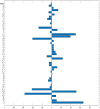Exploring the Interactions of Oncolytic Viral Therapy and Immunotherapy of Anti-CTLA-4 for Malignant Melanoma Mice Model
- PMID: 36766849
- PMCID: PMC9914370
- DOI: 10.3390/cells12030507
Exploring the Interactions of Oncolytic Viral Therapy and Immunotherapy of Anti-CTLA-4 for Malignant Melanoma Mice Model
Abstract
Oncolytic ability to direct target and lyse tumor cells makes oncolytic virus therapy (OVT) a promising approach to treating cancer. Despite its therapeutic potential to stimulate anti-tumor immune responses, it also has immunosuppressive effects. The efficacy of OVTs as monotherapies can be enhanced by appropriate adjuvant therapy such as anti-CTLA-4. In this paper, we propose a mathematical model to explore the interactions of combined therapy of oncolytic viruses and a checkpoint inhibitor, anti-CTLA-4. The model incorporates both the susceptible and infected tumor populations, natural killer cell population, virus population, tumor-specific immune populations, virus-specific immune populations, tumor suppressive cytokine IFN-g, and the effect of immune checkpoint inhibitor CTLA-4. In particular, we distinguish the tumor-specific immune abilities of CD8+ T, NK cells, and CD4+ T cells and describe the destructive ability of cytokine on tumor cells as well as the inhibitory capacity of CTLA-4 on various components. Our model is validated through the experimental results. We also investigate various dosing strategies to improve treatment outcomes. Our study reveals that tumor killing rate by cytokines, cytokine decay rate, and tumor growth rate play important roles on both the OVT monotherapy and the combination therapy. Moreover, parameters related to CD8+ T cell killing have a large impact on treatment outcomes with OVT alone, whereas parameters associated with IFN-g strongly influence treatment responses for the combined therapy. We also found that virus killing by NK cells may halt the desired spread of OVs and enhance the probability of tumor escape during the treatment. Our study reveals that it is the activation of host anti-tumor immune system responses rather than its direct destruction of the tumor cells plays a major biological function of the combined therapy.
Keywords: cytokines; immune checkpoint CTLA-4; mathematical modeling; melanoma; oncolytic virus therapy.
Conflict of interest statement
The authors declare no conflict of interest.
Figures









Similar articles
-
Engineering Newcastle Disease Virus as an Oncolytic Vector for Intratumoral Delivery of Immune Checkpoint Inhibitors and Immunocytokines.J Virol. 2020 Jan 17;94(3):e01677-19. doi: 10.1128/JVI.01677-19. Print 2020 Jan 17. J Virol. 2020. PMID: 31694938 Free PMC article.
-
Novel Oncolytic Herpes Simplex Virus 1 VC2 Promotes Long-Lasting, Systemic Anti-melanoma Tumor Immune Responses and Increased Survival in an Immunocompetent B16F10-Derived Mouse Melanoma Model.J Virol. 2021 Jan 13;95(3):e01359-20. doi: 10.1128/JVI.01359-20. Print 2021 Jan 13. J Virol. 2021. PMID: 33177208 Free PMC article.
-
Oncolytic virotherapy evolved into the fourth generation as tumor immunotherapy.J Transl Med. 2023 Jul 25;21(1):500. doi: 10.1186/s12967-023-04360-8. J Transl Med. 2023. PMID: 37491263 Free PMC article. Review.
-
Localized oncolytic virotherapy overcomes systemic tumor resistance to immune checkpoint blockade immunotherapy.Sci Transl Med. 2014 Mar 5;6(226):226ra32. doi: 10.1126/scitranslmed.3008095. Sci Transl Med. 2014. PMID: 24598590 Free PMC article.
-
Oncolytic Viro-Immunotherapy: An Emerging Option in the Treatment of Gliomas.Front Immunol. 2021 Oct 5;12:721830. doi: 10.3389/fimmu.2021.721830. eCollection 2021. Front Immunol. 2021. PMID: 34675919 Free PMC article. Review.
Cited by
-
Effects of virus-induced immunogenic cues on oncolytic virotherapy.Sci Rep. 2024 Nov 21;14(1):28861. doi: 10.1038/s41598-024-80542-8. Sci Rep. 2024. PMID: 39572761 Free PMC article.
-
Immune evasion in cancer: mechanisms and cutting-edge therapeutic approaches.Signal Transduct Target Ther. 2025 Jul 31;10(1):227. doi: 10.1038/s41392-025-02280-1. Signal Transduct Target Ther. 2025. PMID: 40739089 Free PMC article. Review.
-
Alliance between titans: combination strategies of CAR-T cell therapy and oncolytic virus for the treatment of hematological malignancies.Ann Hematol. 2024 Aug;103(8):2569-2589. doi: 10.1007/s00277-023-05488-9. Epub 2023 Oct 18. Ann Hematol. 2024. PMID: 37853078 Review.
-
Enhancing cancer therapy: the integration of oncolytic virus therapy with diverse treatments.Cancer Cell Int. 2024 Jul 11;24(1):242. doi: 10.1186/s12935-024-03424-z. Cancer Cell Int. 2024. PMID: 38992667 Free PMC article. Review.
-
Mathematical Modeling of Oncolytic Virus Therapy Reveals Role of the Immune Response.Viruses. 2023 Aug 25;15(9):1812. doi: 10.3390/v15091812. Viruses. 2023. PMID: 37766219 Free PMC article.
References
Publication types
MeSH terms
Substances
LinkOut - more resources
Full Text Sources
Medical
Research Materials

